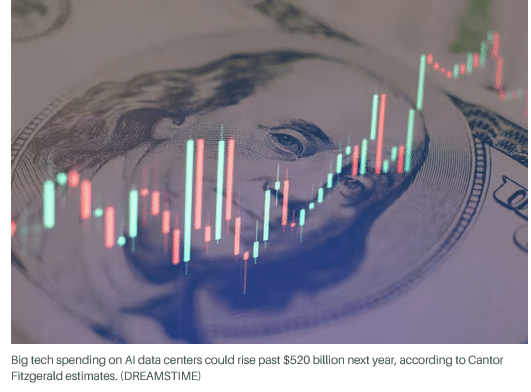
Key Points
- Cantor Fitzgerald analysts project the four major cloud providers will collectively spend $520 billion annually by the end of next year.
- Bank of America data indicates that capital spending by hyperscalers is consuming nearly all cash generated from their existing operations.
- Meta Platforms used a special-purpose vehicle to raise approximately $30 billion, mostly debt, for a Louisiana data center.
One of the many great scenes in The Big Short, which fictionalizes famed investor Michael Burry’s bet against the U.S. housing market, involves a tower of wooden blocks.
During a client pitch, a trader illustrating the risk of collateralized debt obligations unveils a Jenga tower that represents the mortgage bonds stuffed inside a CDO. It inevitably collapses, of course, both on screen and in real life.
A lot of skeptical investors are waiting for a similar implosion of the artificial-intelligence investment boom. The market value of the biggest tech stocks has reached eye-watering levels. The titanic levels of spending being committed to data-center projects simply aren’t generating revenue, let alone profits, in the earliest stage of the cycle.
Cantor Fitzgerald analysts estimate collective annual spending from the four major cloud providers: Microsoft, Google, Amazon.com and Oracle will reach $520 billion by the end of next year.
Bank of America data, meanwhile, suggests capital-spending plans of the biggest tech companies, the so-called hyperscalers, are now swallowing up nearly all of the cash their existing operations produce.
That could suggest AI companies “collectively may be reaching a limit on how much AI capex they are willing to fund purely from cash flows,” said BofA analyst Yuri Seliger.
And that could be why we are seeing a new development in AI financing that bears a striking resemblance to tools used to house a lot of the CDOs that brought the global financial system to its knees in the late 2000s: so-called special purpose vehicles.
SPVs effectively kept billions worth of housing debt off the balance sheets of the country’s biggest banks during the pre-crisis housing boom. That made it harder for investors to understand the risks involved, leaving them with little warning when it all went bad.
In October, Meta Platforms used an SPV called Beignet Investor LLC to raise around $30 billion, most of it debt, that will be used to build a data center in Louisiana. That keeps the debt raised off Meta’s balance sheet, but effectively tied to its broader business prospects.
The company didn’t immediately respond to a request for comment.
Elon Musk’s xAI is reportedly looking to raise $20 billion through an SPV-structured deal that will buy Nvidia processors and lease them back to the AI start-up. Nvidia CEO Jensen Huang said he was “delighted” to be a part of the project.
Cash flow might have been a consideration for Meta, given that around 65% of its current tally is going toward capital spending. The parent of Facebook told investors last week that it would see a “notably larger” capex increase in 2026.
Alphabet, on the other hand, reported third-quarter capex of around $24 billion, which was just under half of its operating cash flow for the period.
That healthy mix likely allowed the Google parent to tap the U.S. bond market for $15 billion on Monday. A portion of the sale matures in 50 years. A further $7 billion will be raised in Europe’s corporate debt market.
Meta has also been able to sell large amounts of debt in the traditional corporate bond market, and raised around $30 billion in October with the fifth-largest issue on record. Oracle sold $18 billion of debt in late September. Both sales drew solid demand from investors.
Dave Novosel, senior analyst at Gimme Credit, thinks the use of SPVs is likely more a reflection of the market having to cope with a big increase in new debt than concern over the health of big-tech balance sheets.
“The hyperscalers and other huge issuers of debt have incredibly strong credit profiles and therefore can easily borrow in the capital markets,” he told Barron’s.
Using an SPV, he said, not only keeps the debt separate but also isolates the risk of a particular project. It gives investors more choices in terms of where they can lend their money.
But it can also raise questions about transparency and market liquidity, given that the market for SPVS is far less active than traditional corporate bonds. Those issues appear more striking when paired with increasing concerns over megacap tech’s dominance of the equity markets, and the increasingly circular nature of AI spending among a handful of players.
OpenAI underscored the latter when it signed a $38 billion deal with Amazon to provide Nvidia chips for its computing needs on Monday.
The ChatGPT creator has now committed to spending around $1.5 trillion over the next decade. Its own estimates peg 2030 revenue at just under $175 billion.
If OpenAI opts to use off-balance sheet tools, as well as traditional debt markets, to fill that gap in financing, investors might start peeking under the hood of these vehicles to find out just how special they are.
And whether we have another Jenga tower to deal with.
Read the full article HERE.


